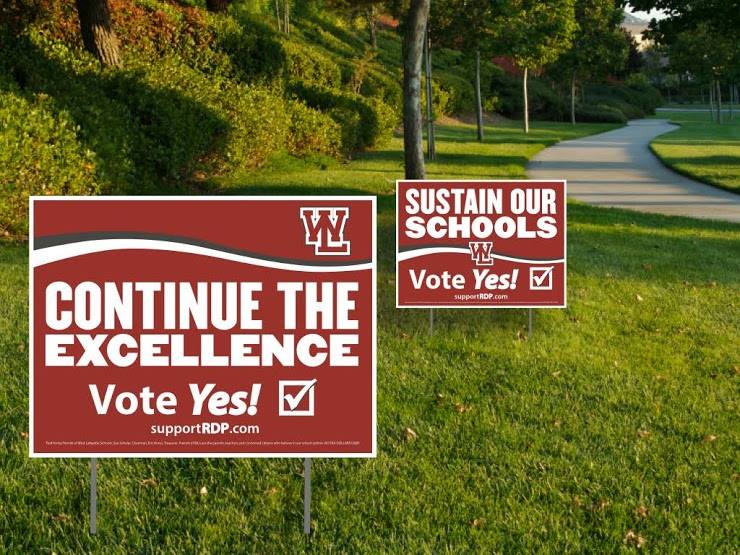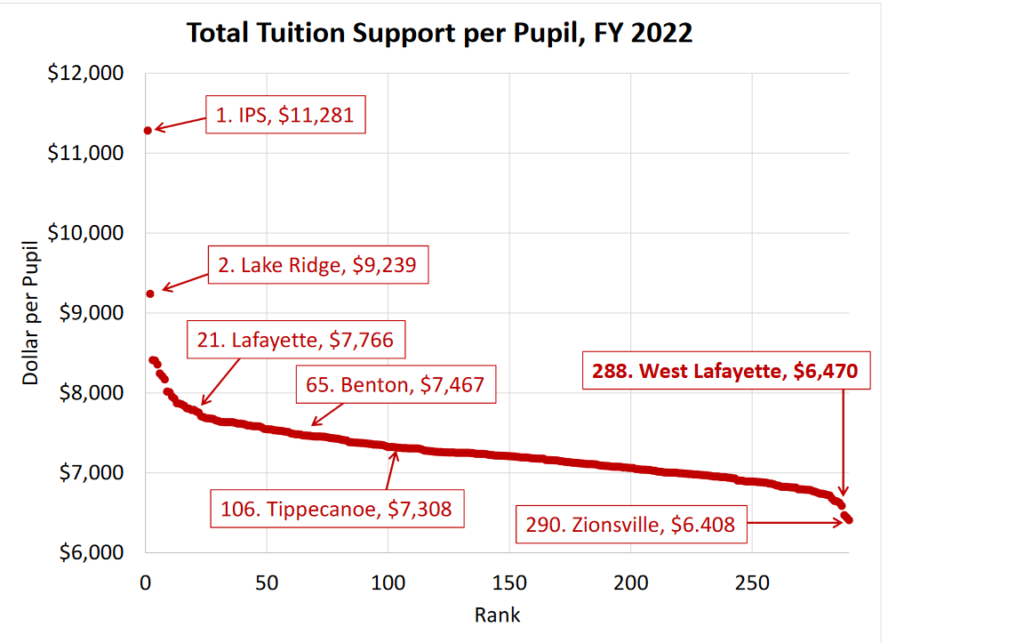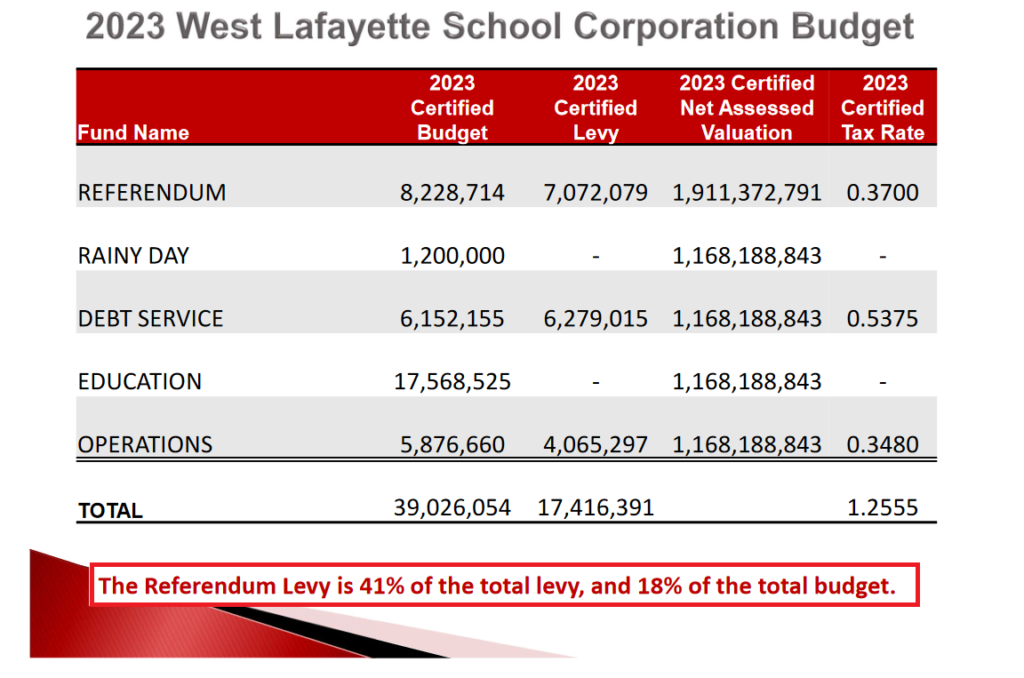West Lafayette Schools will be putting their school tax rate referendum on the November ballot. If you are a voter in the District, please vote “yes.”
Introduction
West Lafayette Schools get 18% of their current funding through a referendum approved property tax rate. Voters in the district need to renew this rate periodically or it goes away. Of the 290 school districts in Indiana, West Lafayette ranks 288th in support from the State under the State School Funding Formula. To maintain the kinds of schools we want, we need to renew the referendum property tax rate.
The State changed the way schools were funded in 2009. The new funding mechanisms put West Lafayette at a disadvantage. In response, to adequately fund our schools, the community took advantage of the new (in 2009) referendum tool, adopting a tax rate in 2010 and again in 2017. Absent money from the referendum tax rate, our schools would not be able to provide the quality of education our community wants. The rate is up for renewal again in November 2023. Non-renewal would mean an 18% reduction in funding, fewer teachers, larger class sizes, and fewer opportunities for our students.
West Lafayette gets less education funding from the State than just about any other school district, even as our district has the highest expectations and ambitions for the quality of education in our community. Renewal of the referendum means that we leave the current tax structure in place and can maintain our excellent schools. The tax rate will remain the same as it has been since the first referendum was approved in 2010. When the time comes, please vote “yes” to approve the referendum.

Vote “yes” to continue the excellence of West Lafayette’s schools. The tax rate will stay the same. State law requires that we vote to renew it periodically.
School Funding in Indiana
In 2008, the Indiana General Assembly substantially restructured its property tax laws. This was in response to an Indiana Supreme Court decision which required the State to change the way it handled real estate assessments. For a variety of reasons, this led to a politically unpopular level of real estate taxes and prompted the State to shift away from real estate taxes in favor of a greater reliance on other types of taxes such as income taxes and sales taxes. This had a significant impact on how schools are funded.
Each school district has three main funds: the education fund, the operations fund, and the debt service fund. School districts like West Lafayette which have adopted a referendum tax rate also have a fourth, referendum fund.
Education Fund – funded by the State through sales taxes
As part of this transition away from real estate taxes, because schools had relied so heavily on such taxes, the State took over the bulk of school funding and increased the statewide sales tax to pay for it. Money provided by the State goes into each school’s “Education Fund.” This is the fund that pays for expenses allocated to student instruction and learning.
The State uses a per-student formula to determine how much money it will put into a school’s Education Fund. This formula is revised every budget year. But, generally, there is a base (foundation) rate which is the same for every school district. Added to this is a “complexity” rate which is tied to a district’s socioeconomic condition. (The number of students eligible for free and reduced lunch subsidies are pretty well correlated with the size of a district’s complexity rate.) (Edit 7/12/2022: I believe I’m out of date on the “complexity rate.” Starting in 2020, the base amount is supplemented with a special education grant, a career and technical grant, and an honors grant — West Side’s supplemental funding above the base rate remains small compared to other districts.)
Because West Lafayette is in better shape economically than most of the rest of Indiana, our supplemental funding from the state above the base rate is small. Consequently, our school district gets the third least amount per student. In 2022, the State contributed $6,470 per West Side student; an amount which ranked 288th out of 290 school districts in the State. The median rate is around $7,250 and the highest per student rate is IPS with $11,281 per student. West Lafayette has approximately 2,420 students meaning the State’s contribution to the Education Fund under this formula would be around $15.6 million. There are some other State contributions that add to this fund and, for 2023, the certified Education Fund budget was $17.5 million.

West Lafayette is nearly last in per pupil funding received by the State. We need to renew our local referendum rate if we want to maintain the quality of our schools.
Operation Fund – funded by local real estate taxes
The school Operation Fund is funded by revenues from local real estate taxes. Schools are inevitably going to have non-classroom operational expenses (e.g. buses, administration, utilities, and a lot of other things needed to support the classroom operations). These sorts of expenses are paid for using the Operation Fund. The 2023 certified budget for this fund was $5.8 million.
The revenues in this fund come from local property taxes which are subject to Indiana’s tax cap laws. (Generally, the total local taxes assessed on a property cannot exceed 1% of the assessed value for residential property, 2% for rental property and agricultural property, and 3% for other kinds of commercial property.)
Debt Service Fund – funded by local real estate taxes
The Debt Service Fund pays for capital expenses, usually bonds and long-term leases for building construction and renovation. Construction costs are an inevitable fact of life for school corporations. Buildings only last so long and sometimes schools need greater capacity. Indiana’s municipal funding rules do not generally permit schools to accumulate taxes in order to save up prior to doing major construction. Therefore these expenses are usually paid for through bond issuances or (for arcane historical reasons) long-term leases with a municipal building corporation (which are functionally the same thing as bonds.)
The 2023 certified budget for WLCSC’s debt service fund was $6.2 million. Revenues in this fund are not permitted to be used for non-capital purposes such as teacher salaries. Occasionally when school funding is discussed, people argue that teachers could be paid more if the school buildings were not so nice. Leaving aside the fact that kids don’t learn well in squalor, taxes imposed for the debt service fund are not permitted to be used for operational purposes such as increasing teacher pay.
The taxes levied to support the debt service fund are also subject to Indiana’s tax cap laws. (1% cap on owner-occupied residential, 2% cap on rental and agricultural property, and 3% on other commercial property). In Indiana, debt service on bonds is usually protected. Therefore, if the tax caps cause a shortfall in revenues, bonds will get paid and the shortfall will be taken out of the other funds. For West Lafayette, this means that the Operation Fund bears the brunt of these “circuit breaker” credits. Due to tax caps, the Operation Fund gets reduced by approximately 31% of what would otherwise be generated.
Referendum Fund – funded by local real estate taxes
The Referendum fund consists of money from a referendum approved tax rate. This is the rate that will be on the ballot because the State requires it to be renewed by voters periodically. This rate is not subject to the tax caps. In 2010, when the district first approved the rate, the voters approved a referendum tax rate of up to $0.43 per hundred dollars of assessed value. Even though the rate was approved at up to that level, in practice the school board never approved a budget imposing a tax rate that high. The approved rate ends up being a maximum. The actual amount is based on the budget approved by the school board each year. Between 2010 and 2017, the budget approved by the school board each year never included a referendum rate that exceeded $0.37 per hundred dollars of assessed value. Therefore, when it came time to renew the tax rate, the maximum referendum rate on the ballot was lowered by the school board from $0.43 to $0.37 per hundred dollars of assessed value. (This did not stop the Journal and Courier from running a headline at the time suggesting that the School Board was trying to raise taxes.)
Money in the current referendum fund (approved, as it was, via the process in place in 2017) can be used for any lawful school expense. Historically money from that rate has been used in West Lafayette for student instruction and learning. In recent years, the State created certain incentives making it beneficial for the schools to spend less State money on non-instructional operations. (As a political matter, it’s more popular to declare that money is spent on instruction rather than on the more mundane administrative expenses that make instruction possible). So, West Lafayette removed some operational expenses from the Education Fund and began paying for them from the Referendum Fund and moved some educational expenses from the Referendum Fund to the Education Fund.
Changes in the referendum process since 2017 require the school to specify the uses in the referendum question. The upcoming referendum will likely specify that revenues will be used “for the purpose of retaining and attracting teachers and staff and funding academic programming and operating expenditures.” Functionally, this would appear to permit paying for expenses that would otherwise be payable out of the Education or Operation funds but not for expenses that would be payable out of the Debt Service fund.

Referendum funds make up 18% of the School’s total budget. If the referendum rate goes away, so does 18% of the school’s funding and, with it, manageable class sizes and many of the programs that make West Side great.
The Property Tax Bill
The referendum tax rate has an impact on local real estate tax bills. Those can be confusing, so it might be useful to look at how the tax bill works.
A real estate tax bill for a homeowner starts with the gross assessed value of the home. In rough terms, this should be something like the market value of the home. That assessed value is reduced by a series of deductions (most commonly, the homestead deduction, the “supplemental standard” deduction, and a mortgage deduction). The gross assessed value minus the deductions results in the net assessed value. The net assessed value is multiplied by a tax rate to generate the amount of tax owed. The tax rate consists of the combined tax rates of the taxing jurisdictions in which a home is located – generally, the city, the county, the school district, the township, the library district and the solid waste management district. If the resulting tax bill exceeds (in the case of an owner-occupied home) 1% of the gross assessed value, then the tax caps kick in and generate a “circuit breaker” credit in an amount sufficient to lower the tax bill to the cap amount.

I know, I know. This stuff gets confusing.
Let’s take as an example, a home with a $200,000 gross assessed value. That property is entitled to a homestead deduction of $45,000. It is also entitled to a “supplemental standard” deduction of 35% of the assessed value (after the homestead deduction). That would be another $54,200 deduction. A mortgage deduction of $3,000 would result in total deductions of $102,200 and a net assessed value of $97,800. (The $200,000 gross assessed value minus the combined deductions.)
The net assessed value is multiplied by the tax rate to determine the amount of tax owed. Each parcel of real estate exists within the jurisdiction of multiple taxing units. Most (but not all) real estate in the West Lafayette school district also exists within Tippecanoe County, the City of West Lafayette, the West Lafayette Library District, Wabash Township, and the Tippecanoe County Solid Waste Management District. Each of those jurisdictions impose a tax rate. Tax rates are expressed in terms of dollars per hundred dollars of assessed value. For 2022/pay 2023 (taxes in Indiana are assessed in one year and paid the following year), those tax rates were:
- County 0.4156
- Township 0.0026
- School 1.2555*
- City 0.8729
- Library 0.1768
- Solid Waste 0.0503
- Total: 2.7737
*Of the 1.2555 School tax rate, 0.37 comes from the referendum, 0.5375 comes from the debt service fund, and 0.3480 comes from the operations fund. Because the referendum fund is not subject to tax caps, only 0.8855 of the school tax rate and 2.4037 of the total tax rate is subject to the 1% tax cap. That becomes important in a moment.
The $2.7737 per $100 of assessed value is multiplied by the $97,800 net assessed value ($978 * 2.7737) to generate a tax bill of $2,712.68. There is yet another tax deduction having to do with a local income tax imposed in Tippecanoe County for the purpose of providing property tax relief. That provides another deduction which amounts to about $223 and a tax bill of $2,489.68. Now the tax caps kick in. For an owner-occupied residence with a gross assessed value of $200,000, a 1% — $2,000 – cap applies.
Recall that $361.86 from the referendum ($978 * .37) is outside of the tax cap. The remaining $2,127.82 ($2,489.68 – $361.86) is governed by the cap. Because of the cap, the taxpayer gets an additional “circuit breaker” credit of $127.82 resulting in a total tax bill of $2,361.86. If the referendum rate were not in place, the total tax bill would be $2,000.
West Lafayette’s Need
The referendum fund will generate approximately $7 million or about $2,900 per student for West Lafayette Schools in 2023. This represents approximately 18% of the school’s $39 million annual budget. Reducing the budget by 18% would have a severe impact on our students and on our community. It would mean fewer teachers, larger classes, and a reduction in art, music, and extra-curriculars.
The referendum question that is likely to appear on the ballot would specify that money from the referendum rate would be “for the purpose of retaining and attracting teachers and staff and funding academic programming and operating expenditures.”
A variety of factors make West Lafayette a good candidate for the referendum rate:
- Low State funding. West Lafayette gets the third lowest per student funding in the State.
- Landlocked District. The State funds schools on a per-student basis. West Lafayette already has the highest population density in the State. There is not a significant opportunity for further development in the school boundaries that is likely to add substantially more students.
- High real estate values. The “supplemental standard” tax deduction is a percentage of a property’s value, meaning that addition of this deduction by the General Assembly removes more assessed value from the West Lafayette school district than average. High values also mean that, in general, the residents of West Lafayette have greater wherewithal to fund a referendum rate.
- TIF Districts. A TIF District is an economic development tool that (more or less) sets a base assessed value for a specified geographic area at a particular moment in time. When that assessed value grows, the additional tax revenue is used for economic development rather than for other tax purposes (such as for school funding.) More of West Lafayette than average is locked up in TIF Districts. In West Lafayette, 39% of the net assessed value is in TIF districts compared to a statewide average of 9%. This means that growing assessed value does not assist the operations fund or the education fund. Referendum rates are not subject to the TIF limitations.
- Rental properties. West Lafayette has more rental properties than usual. They are subject to a 2% tax cap rather than the 3% cap that applies to other types of commercial property.
- Textbook and curricular fees. A new wrinkle in State law this year is that schools are prohibited from charging fees for textbooks and other curricular materials. The State will provide some funding to compensate for the lost revenue, but at the time I write this, it seems likely that state funding will fall short of the lost revenue.
Conclusion
As Caleb Mills said on the subject of Indiana education in 1848, “There is but one way to secure good schools, and that is to pay for them.” But there is a related quote from Dr. Mills that is even more relevant to the referendum question: “Awaken the public mind, and concentrate it on the question, ‘Am I not interested in the proper education of all that are socially and politically connected with me?’”
A good education is not just a benefit to those students who happen to be in the school district at the moment. Quality schools benefit the community generally. They attract people who want the best for their children. They produce adults who are productive, creative, and give back to the community. Whether you have students in the schools or not, our great schools make West Lafayette a better place to live.
The State provides West Lafayette with less education funding than other school districts in Indiana. By voting “yes” to the referendum question, we will ensure that the tax rate remains the same and our schools will continue to be funded adequately.
(I drew a great deal of information from Dr. Larry DeBoer’s May 22, 2023, presentation to the West Lafayette School Board. His power point is available here.)

RDP! Vote “Yes” and keep our schools strong.
Well written Doug. A friend told me you did a great job authoring this and presenting the financial data accurately that people can understand. Also, I hear there are some citing DOE data indicating that WL schools get over $9000 per student. They need reminding that number includes debt service, transportation costs, etc. The legislators use ALL funding received and divide it by the number of students to come up with that number. However, they don’t tell taxpayers that debt service funds can’t be used to pay for teachers, etc. So I have always focused on the state basic grant per student. I believe in 2009 WL was receiving about $6400 per student. By 2014 I believe that number was down to to $4800 per student. When I left in 2021 I believe WL was receiving $6200 per student. During a 12 year period WL still hadn’t reached the per student basic grant amount we were receiving in 2009.
Keep up the great work.
Thanks Rocky. I had a conversation with someone recently who had been using the DOE data. Might be the same one. I figured that the $9k/student involved some combination of state and local sources, but I wasn’t sure how the math worked out exactly.
I was relying on the information provided by Larry DeBoer, so I felt like I was on solid ground!
Larry and you are on the same page. I also heard one board member wanted to add to the question “reduce class sizes.” That’s nearly an impossible task when there aren’t any more classrooms available. Plus with students moving in and out all through the school year, that kind of requirement could bankrupt the referendum.
Yes, I was glad to see that particular motion fail. It was a little odd – the motion was for “reduce” class size, but a fair amount of the discussion was around “manage” or “maintain” class size. Nobody made a motion to include “manage” or “maintain.”
Other than the timing, I probably wouldn’t have personally minded “manage.” But my understanding is that changing the wording at this meeting would have delayed the process. And, even with the current language, the board and the administration can and will use the referendum funds to manage class sizes.
Ultimately, the bigger issue is that, without this referendum funding class sizes at West Side would increase by quite a bit from current levels.
Absolutely correct Doug. Larry DeBoer and Dave Hummels projected that if our first referendum failed in 2010 class sizes would be over 40 students per class at the elementary alone.